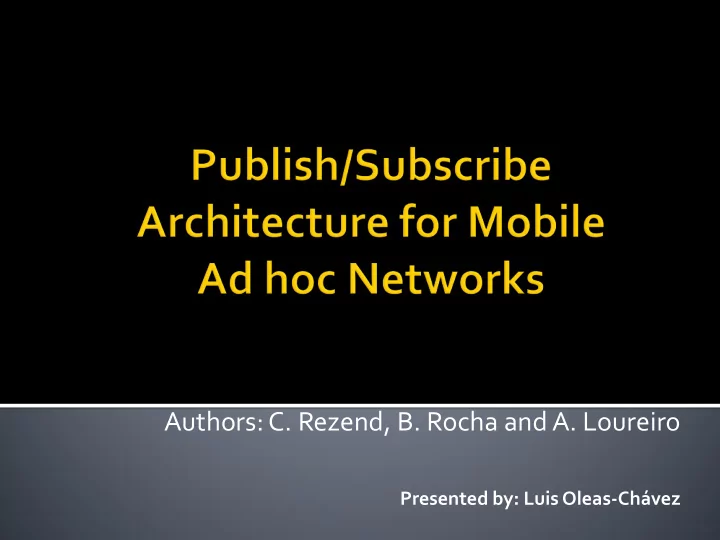

Authors: C. Rezend, B. Rocha and A. Loureiro Presented by: Luis Oleas-Chávez
Publish/Subscribe – Concepts & Applications Dissemination tree Beacon exchanges Gossip algorithm Related Work Architecture Publication Buffer Subscription Table Experiments and Results Tuning Performance Analysis Conclusions
Publish/Subscribe is a one-to-many communication paradigm Publisher : Publishes structured events to an event service. Subscribers : Register their interest in an event, or pattern of events, and are asynchronously notified of events generated by publishers. Event Notification Service : Provides storage and management for subscriptions and efficient delivery of events.
Topic-Based : It is based in the notion of groups (many-to-many relationship). Content-Based : Subscriptions are related to specific information by specifying filters (many-to-one relationship). Type-Based : Events are filtered by their type. It provides guarantees such as type safety and encapsulation.
Key properties: Full decoupling of the communication entities Space Time Synchronization
Applications • Financial information systems • Live feeds of real- time data (including RSS feeds) • Cooperative working environments with many participants with shared interests in events • Ubiquitous computing • Monitoring applications
Publish/Subscribe architecture has been deeply studied and applied in wired networks. The incursion of a mobile Ad hoc Network (MANET) presents challenges which can be minimized using the nodes movement to disseminate publications to the whole network with a reduced number of transmissions. These nodes will be responsible for disseminating locally received publications to different areas of the network after they move
Previous proposals that make reference to wireless networks, in fact were adaptations of existing wired networks architectures. Propagation techniques discarded: Dissemination trees (Huang) Beacons exchanges (Baehni) Gossip-based algorithm
The purpose of this architecture is the use of mobility to notify interested subscribers of messages sent by publishers in a mobile ad hoc network using a minimum amount of broadcasts. The developed PSAMANET is based on signatures which describe the interested structured content and publications in a way that its content is readable.
The number of publications are predefined by a value R; thus, subscriptions are defined in a range of interested values [ v min ,v max ]. Subscriptions are sent to neighbors when: A node has been created A node stops after it had moved Publications are broadcast when: A node has been created A node stops A node has a publication which matches a new incoming subscription A node receives a publication which matches any stored and still valid subscription
A PB is a FIFO queue that stores the incoming publications in every node. The PB stores the PB size more recent received publications. PB size is given by: Increases the number of reached nodes Impacts the number of messages sent PB considers an upper bound to the number of publications forwarded each time PB max in the case more than PB max publications have to be sent.
A node must hold no only the FIFO queue but also a subscription table which stores the nodes subscriptions. An important observation is that subscriptions do not stay for a long time in the ST. Then, two types of subscriptions are considered: Own (ST is cleaned when it moves) Foreign (Subscription valid for an amount of time ST ttl ) Every time the ST is used, it first checks for expired subscriptions and remove them. Duplicate received publications are avoid with the help of S prob . It reduced the amount of bandwidth and energy wasted
In the experiment, the density of the network is such that a node has an average of four neighbors. It was implemented on NS-2 simulator The movement used was Random Way Point.
Each node subscribe to two different ranges which are generated randomly. S range : Set to a value which makes a publication to be of the interest to 20% of nodes (R/400) v min : Positive number smaller or equal to R v max : Minimum value plus a constant range S range Total number of publications: 1000 Experiment phases: Tuning (PB size , PB max , S ttl and S prob ) Performance analysis
Initial values PB size : influences how long a publication lasts in the network PB max : how many times a publication is sent S ttl : 300 S prob : 0.4 There are 1000 publications during each simulation PB size : 1000 (unlimited buffer)
Evaluate configurations with a small number of messages and others with high match rates. Subscriptions parameters with four PB configurations with (PB max , PB size ). (5, 200), (10,200), (25, 300), and (50, 500) Foreign subscriptions last for 60 sec. The first observation was that the S ttl does not have a great impact on the number of messages sent nor on the match rate.
This experiment was tested against a gossip- based routing algorithm for ad hoc networks, where every subscriber stores its subscriptions. The publisher broadcasts its publications and whenever a node receives any publication it has a probability of G prob to forward it.
This work presents a solution to the problem of developing a PSAMANET which properly adapts to the highly dynamic topology of such networks using nodes’ movement to disseminate publications. It considers a totally asynchronous communication in such a way that end-to-end delays of minutes are not a problem and moving nodes can connect distant regions of the network with fewer transmissions. The results showed a much better performance than the Gossip algorithm. For instance, it was possible to reach a 46% higher match rate sending 10% less messages.
To analyze of PSAMANET behavior as a complex network to observe properties like degree distribution and diameter. To study the Publisher/Subscriber paradigm in MANETs for real-time applications and also try to use mobility without incurring in a high delay.
Recommend
More recommend